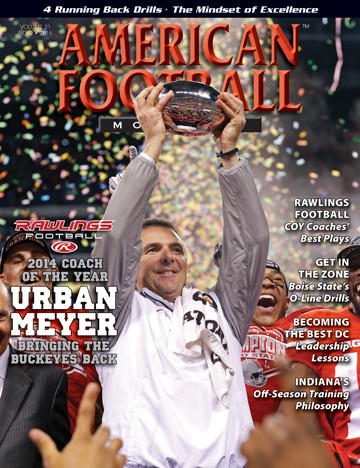AMERICAN FOOTBALL MONTHLY THE #1 RESOURCE FOR FOOTBALL COACHES
|
|
Article Categories
|
Zoned In - Inside zone drills for covered and uncovered linemenby: Chennis BerryAssistant Head Coach, Co-Offensive Coordinator and Offensive Line Coach, Southern University© More from this issueTo get the most out of our O-linemen we use an effective drill called the Board Drill, which is part of our every day drills. We buy into it and start each day on the boards to develop great departure angles, contact, and follow through.
The inside zone is the area blocking scheme where the covered lineman blocks on and the uncovered lineman blocks the playside gap often resulting in combinations. The O-linemen must read the near foot of the first DL. Movement is the key. The OL and RBs steps should mirror each other.
INSIDE ZONE (COVERED LINEMAN)
Departure Angle
• First step is a zone step. The width and depth of this step is determined by the alignment of the defender. Get it in the ground quick.
• Eyes are one inch outside the defender’s midline. Work the hat outside. Ai....The full article can only be seen by subscribers.
Subscribe today!

|
|
|
NOT A SUBSCRIBER?
Subscribe
now to start receiving our monthly magazine PLUS get INSTANT
unlimited access to over 4000 pages of 100 percent football coaching
information, ONLY available at AmericanFootballMonthly.com!
|
|
|
HOME
|
MAGAZINE
|
SUBSCRIBE
|
ONLINE COLUMNISTS
|
COACHING VIDEOS
|
Copyright 2025, AmericanFootballMonthly.com
All Rights Reserved






